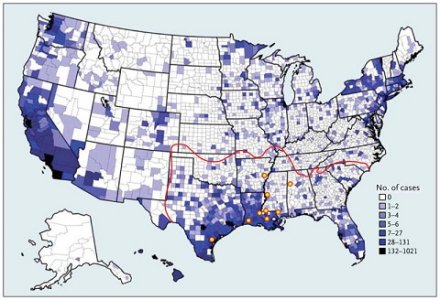Interesting info from Wiki on it:
 MDT patient packs and blisters
MDT patient packs and blisters
Promin was synthesised in 1940 by Feldman of Parke-Davis and company.[43] Although Parke-Davis synthesised the compound, it seems certain that they were not the first. In the same year that Gelmo described sulphanilamide (1908), Emil Fromm, professor of chemistry in the medical faculty of the University of Freiburg im Breisgau, in Germany, described another compound related to the sulphonamides: this was diaminodiphenylsulphone or dapsone (DDS). No one recognised the potential of this compound until Buttle and his colleagues at the Wellcome laboratories and Fourneau and the researchers at the Institut Pasteur simultaneously found in 1937 that dapsone was ten times as potent against streptococcal infection in mice and about a hundred times as toxic as sulphanilamide.[44]
Until the introduction of treatment with promin in the 1940s, there was no effective treatment for leprosy. The efficacy of promin was first discovered by Guy Henry Faget and his co-workers in 1943 at Carville, Louisiana. Robert Cochrane was the first to use DDS, the active component of promin, at the Lady Willingdon Leprosy Settlement, in Chingleput, near Madras, India. John Lowe was the first to successfully administer DDS orally at Uzuakoli Leper Settlement, in Nigeria, in spite of indications that the drug was highly toxic. Both innovations made it possible to produce a treatment that was cheap, seemingly effective, and could be distributed on a large scale.
Scientists eventually realised that DDS was only weakly bactericidal against M. leprae, and it was considered necessary for patients to take the drug indefinitely. When dapsone was used alone, the M. leprae population quickly evolved antibiotic resistance. By the 1960s, the world's only known anti-leprosy drug became ineffective against resistant bacteria.
The search for more effective anti-leprosy drugs led to the use of clofazimine and rifampicin in the 1960s and 1970s.[4] Later, Indian scientist Shantaram Yawalkar and his colleagues formulated a combined therapy using rifampicin and dapsone, intended to mitigate bacterial resistance.[5] The first trials of combined treatment were carried out in Malta in the 1970s.
Multidrug therapy (MDT) combining all three drugs was first recommended by a WHO Expert Committee in 1981. These three anti-leprosy drugs are still used in the standard MDT regimens. None of them is used alone because of the risk of developing resistance.
As this treatment was quite expensive, it was not quickly adopted in most countries where the disease is endemic. In 1985, leprosy was still considered a public health problem in 122 countries. The 44th World Health Assembly (WHA), held in Geneva in 1991, passed a resolution to eliminate leprosy as a public-health problem by the year 2000 – defined as reducing the global prevalence of the disease to less than 1 case per 10,000. At the Assembly, the World Health Organization (WHO) was given the mandate to develop an elimination strategy by its member states. This was based on increasing the geographical coverage of MDT and patients' accessibility to the treatment. Novartis produces this medication for free.
Modern treatments
 MDT patient packs and blisters
MDT patient packs and blistersPromin was synthesised in 1940 by Feldman of Parke-Davis and company.[43] Although Parke-Davis synthesised the compound, it seems certain that they were not the first. In the same year that Gelmo described sulphanilamide (1908), Emil Fromm, professor of chemistry in the medical faculty of the University of Freiburg im Breisgau, in Germany, described another compound related to the sulphonamides: this was diaminodiphenylsulphone or dapsone (DDS). No one recognised the potential of this compound until Buttle and his colleagues at the Wellcome laboratories and Fourneau and the researchers at the Institut Pasteur simultaneously found in 1937 that dapsone was ten times as potent against streptococcal infection in mice and about a hundred times as toxic as sulphanilamide.[44]
Until the introduction of treatment with promin in the 1940s, there was no effective treatment for leprosy. The efficacy of promin was first discovered by Guy Henry Faget and his co-workers in 1943 at Carville, Louisiana. Robert Cochrane was the first to use DDS, the active component of promin, at the Lady Willingdon Leprosy Settlement, in Chingleput, near Madras, India. John Lowe was the first to successfully administer DDS orally at Uzuakoli Leper Settlement, in Nigeria, in spite of indications that the drug was highly toxic. Both innovations made it possible to produce a treatment that was cheap, seemingly effective, and could be distributed on a large scale.
Scientists eventually realised that DDS was only weakly bactericidal against M. leprae, and it was considered necessary for patients to take the drug indefinitely. When dapsone was used alone, the M. leprae population quickly evolved antibiotic resistance. By the 1960s, the world's only known anti-leprosy drug became ineffective against resistant bacteria.
The search for more effective anti-leprosy drugs led to the use of clofazimine and rifampicin in the 1960s and 1970s.[4] Later, Indian scientist Shantaram Yawalkar and his colleagues formulated a combined therapy using rifampicin and dapsone, intended to mitigate bacterial resistance.[5] The first trials of combined treatment were carried out in Malta in the 1970s.
Multidrug therapy (MDT) combining all three drugs was first recommended by a WHO Expert Committee in 1981. These three anti-leprosy drugs are still used in the standard MDT regimens. None of them is used alone because of the risk of developing resistance.
As this treatment was quite expensive, it was not quickly adopted in most countries where the disease is endemic. In 1985, leprosy was still considered a public health problem in 122 countries. The 44th World Health Assembly (WHA), held in Geneva in 1991, passed a resolution to eliminate leprosy as a public-health problem by the year 2000 – defined as reducing the global prevalence of the disease to less than 1 case per 10,000. At the Assembly, the World Health Organization (WHO) was given the mandate to develop an elimination strategy by its member states. This was based on increasing the geographical coverage of MDT and patients' accessibility to the treatment. Novartis produces this medication for free.



